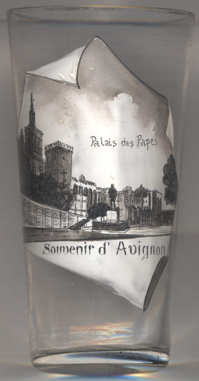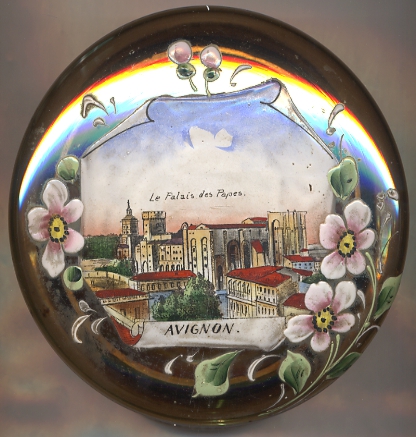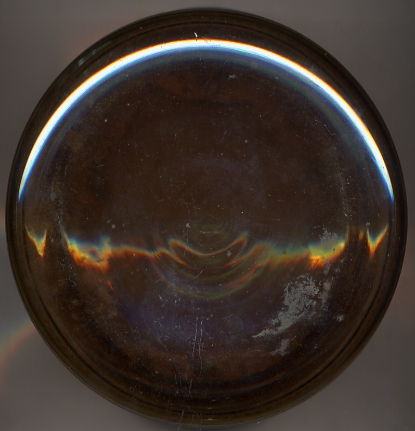

|
| FRANCE | FRANCE |
| région: Provence-Alpes-Côte d'Azur | |
| département: 84, Vaucluse |
 Avignon (Provençal Occitan: Avinhon in classical norm or Avignoun in Mistralian norm)
is situated on the left (east) bank of the Rhône river, a few kilometres above its confluence with the Durance, about 580 km south-east of Paris,
229 km south of Lyon and 85 km north-north-west of Marseille.
Of the 94,787 inhabitants (2010) of the city, about 12,000 live in the ancient town centre surrounded by its medieval ramparts.
Often referred to as the "City of Popes" because of the presence of popes and antipopes from 1309 to 1423 during the Catholic schism, it is currently the largest city and capital
of the département Vaucluse. It is one of the few French cities to have preserved its ramparts. In addition, its historic centre, the palace of the popes, Rocher des Doms,
and the bridge of Avignon are well-preserved. It was classified a World Heritage Site by UNESCO in 1995.
In 2000, Avignon held the title of European Capital of Culture (together with Bergen, Bologna, Brussels,
Helsinki, Kraków, Prague, Reykjavik and Santiago de Compostela;
see list of other European Capitals of Culture depicted on glasses of this collection).
Avignon (Provençal Occitan: Avinhon in classical norm or Avignoun in Mistralian norm)
is situated on the left (east) bank of the Rhône river, a few kilometres above its confluence with the Durance, about 580 km south-east of Paris,
229 km south of Lyon and 85 km north-north-west of Marseille.
Of the 94,787 inhabitants (2010) of the city, about 12,000 live in the ancient town centre surrounded by its medieval ramparts.
Often referred to as the "City of Popes" because of the presence of popes and antipopes from 1309 to 1423 during the Catholic schism, it is currently the largest city and capital
of the département Vaucluse. It is one of the few French cities to have preserved its ramparts. In addition, its historic centre, the palace of the popes, Rocher des Doms,
and the bridge of Avignon are well-preserved. It was classified a World Heritage Site by UNESCO in 1995.
In 2000, Avignon held the title of European Capital of Culture (together with Bergen, Bologna, Brussels,
Helsinki, Kraków, Prague, Reykjavik and Santiago de Compostela;
see list of other European Capitals of Culture depicted on glasses of this collection).
The site of Avignon was settled very early on; the rocky outcrop (le Rocher les Doms) at the north end of the town, overlooking the Rhône River, may have been the site of a Celtic oppidum or hill fort. Avignon, written as Avennio or Avenio in the ancient texts and inscriptions, takes its name from the Avennius clan. Under the Romans, Avenio was a flourishing city of Gallia Narbonensis, the first Transalpine province of the Roman Empire. During the inroads of the Goths, it was badly damaged in the 5th century and belonged in turn to the Goths, the kingdoms of Burgundy and of Arles, in the 12th century. It fell into the hands of the Saracens and was destroyed in 737 by the Franks under Charles Martel. In 1033, when Emperor Konrad II inherited the Kingdom of Arelat, Avignon passed to the Holy Roman Empire. With the German rulers at a distance, Avignon set up as a republic with a consular form of government, between 1135 and 1146. At the end of the twelfth century, Avignon declared itself an independent republic, but independence was crushed in 1226 during the crusade against the Albigenses. After the citizens refused to open the gates of Avignon to King Louis VIII of France and the papal Legate in 1226, Avignon was forced to capituate after a three-month siege. Following the defeat, they were forced to pull down the ramparts and fill up the moat of the city. In 1251 Avignon was made a common possession of counts Charles of Anjou and Alphonse de Poitiers, brothers of French king Saint Louis IX. On 25 August 1271, at the death of Alphonse de Poitiers, Avignon and the surrounding countship Comtat-Venaissin were united with the French crown. However, Avignon and the Comtat did not become French until 1791.
In 1274, the Comtat became a possession of the popes, with Avignon itself, self-governing, under the overlordship of the Angevin count of Provence (who was also king of "Sicily" [i.e. Naples]). The popes were allowed by the count of Provence (a papal vassal) to settle in Avignon in the early 14th century. In 1309 the city, still part of the Kingdom of Arles, was chosen by Pope Clement V as his residence, and from 9 March 1309 until 13 January 1377 was the seat of the Papacy instead of Rome. Queen Joanna I of Sicily, as countess of Provence, sold the city to Clement VI for 80,000 florins in 1348 and, though it was later the seat of more than one antipope, Avignon belonged to the Papacy until 1791, when, during the disorder of the French Revolution, it was reincorporated with France. Seven Popes resided here: Clement V (1305–1314), John XXII (1316–1334), Benedict XII (1334–1342), Clement VI (1342–1352), Innocent VI (1352–1362), Urban V (1362–1370) and Gregory XI (1370–1378). During the Great Schism (1378–1415) the antipopes Clement (VII) and Benedict (XIII) returned to reside at Avignon. Clement lived in Avignon during his entire anti-pontificate, while Benedict only lived there until 1403 when he was forced to flee to Aragon. From the 15th century onward it became the policy of the Kings of France to consider Avignon part of their kingdom. In 1768–1774 the Comtat Venaissin was occupied by King Louis XV, and in 1793 Avignon and the Comtat were integrated along with the former principality of Orange to form the present republican département Vaucluse. The Treaty of Tolentino (19 February 1797) definitively sanctioned the annexation, which was only recognised by Pope Pius VII in 1814.
 The
The  Palais des papes (Palace of the Popes) [background centre]
is one of the largest and most important medieval Gothic buildings in Europe (with 15,000 m² of floor space, the Palais is the biggest Gothic palace in all of Europe).
One time fortress and palace, the papal residence was the seat of Western Christianity during the
14th century. The Palais is actually made up of two buildings: the old Palais of Benedict XII which sits on the impregnable Rocher des Doms, and the new Palais of Clement VI,
the most extravagant of the Avignon popes. Not only is the final combination the largest Gothic building of the Middle Ages, it is also one of the best examples of the International
Gothic architectural style. Due to its immense size, the Palais was also the place where the general organisation of the Church began to change. It facilitated the centralisation of
services and the adaption of operations in order to suit the needs of the papacy, creating a truly central administration for the Church. The strength of the Curia (Church administration),
200 at the end of the 13th century, surpassed 300 at the beginning of the 14th century and reached 500 people in 1316. To this was added over 1,000 lay officials working within the Palais.
Despite this, the Palais became obsolete when the papacy found it necessary to return to Rome. In the following centuries, the Palais lost all of its former glory.
Since 1995, the Palais des Papes has been classified, along with the historic center of Avignon, as a UNESCO World Heritage Site.
Palais des papes (Palace of the Popes) [background centre]
is one of the largest and most important medieval Gothic buildings in Europe (with 15,000 m² of floor space, the Palais is the biggest Gothic palace in all of Europe).
One time fortress and palace, the papal residence was the seat of Western Christianity during the
14th century. The Palais is actually made up of two buildings: the old Palais of Benedict XII which sits on the impregnable Rocher des Doms, and the new Palais of Clement VI,
the most extravagant of the Avignon popes. Not only is the final combination the largest Gothic building of the Middle Ages, it is also one of the best examples of the International
Gothic architectural style. Due to its immense size, the Palais was also the place where the general organisation of the Church began to change. It facilitated the centralisation of
services and the adaption of operations in order to suit the needs of the papacy, creating a truly central administration for the Church. The strength of the Curia (Church administration),
200 at the end of the 13th century, surpassed 300 at the beginning of the 14th century and reached 500 people in 1316. To this was added over 1,000 lay officials working within the Palais.
Despite this, the Palais became obsolete when the papacy found it necessary to return to Rome. In the following centuries, the Palais lost all of its former glory.
Since 1995, the Palais des Papes has been classified, along with the historic center of Avignon, as a UNESCO World Heritage Site.
The  Cathédrale Notre-Dame des Doms d'Avignon (Avignon Cathedral) [background left]
is the seat of the Archbishop of Avignon. The cathedral is a Romanesque building, mainly of the 12th century, the most prominent feature of which is the gilded statue of the
Virgin Mary which surmounts the western tower since 1859. Among the many works of art in the interior, perhaps the most beautiful is the mausoleum of Pope John XXII, a masterpiece
of Gothic carving of the 14th century.
Cathédrale Notre-Dame des Doms d'Avignon (Avignon Cathedral) [background left]
is the seat of the Archbishop of Avignon. The cathedral is a Romanesque building, mainly of the 12th century, the most prominent feature of which is the gilded statue of the
Virgin Mary which surmounts the western tower since 1859. Among the many works of art in the interior, perhaps the most beautiful is the mausoleum of Pope John XXII, a masterpiece
of Gothic carving of the 14th century.

[http://en.wikipedia.org/wiki/Avignon;
http://en.wikipedia.org/wiki/Palais_des_Papes;
http://en.wikipedia.org/wiki/Notre_Dame_des_Doms, http://fr.wikipedia.org/wiki/Cath%C3%A9drale_Notre-Dame_des_Doms_d%27Avignon]
![[scale]](lineal.jpg)